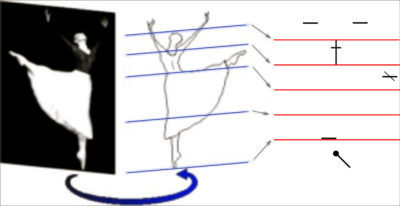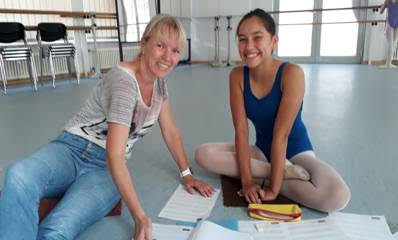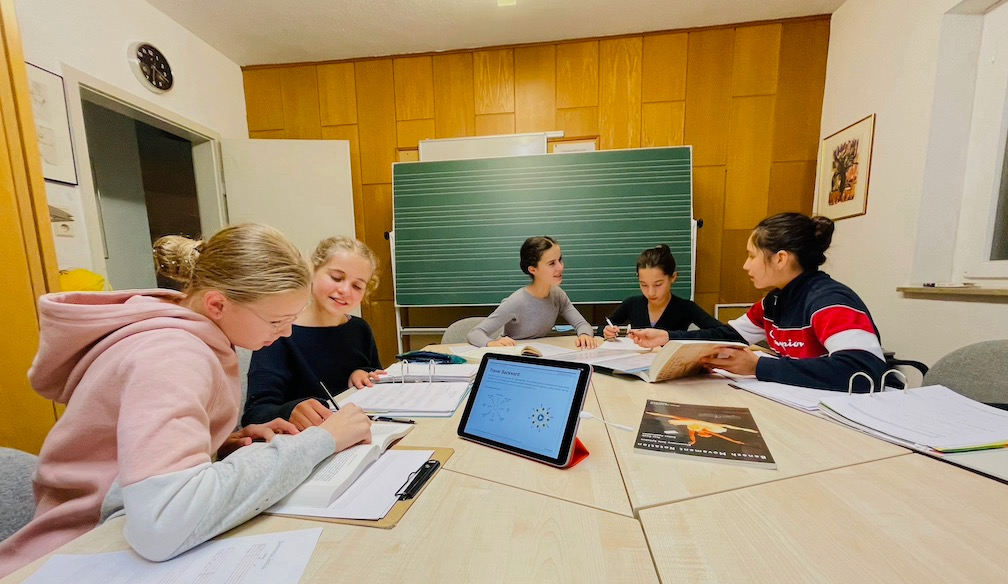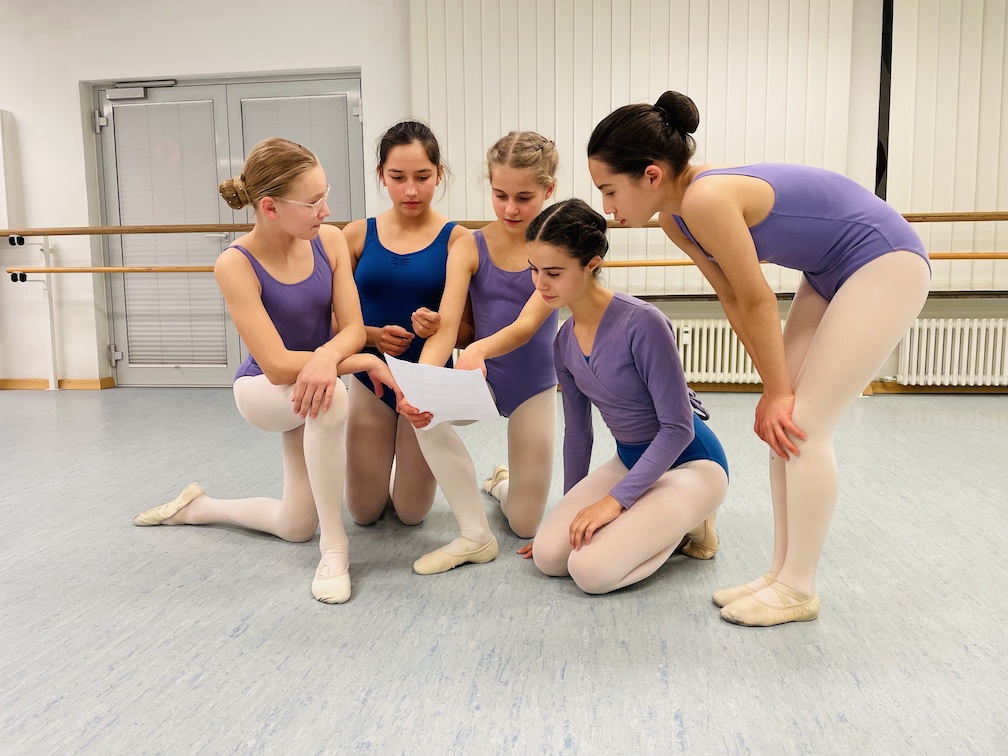COVID Collaborations
Rhonda Ryman-Kane and Robyn Hughes Ryman
In June 2016, Liz Cunliffe wrote an article for the RAD Dance Gazette. It was an interview with Gisela Ronecker-Wiesenauer, founder and owner of Ballettfachschule Ronecker in a suburb of Stuttgart, Germany, called Fellbach. The interview discussed teaching the ‘secret language’ of notation to her young students.
Fast forward to the COVID-19 Pandemic, and we discovered Ronecker making “lemonade out of lemons” by integrating Benesh Movement Notation (BMN) and Classical Ballet via online meetings. Her lockdown project continued to use the study of dance notation to complement the study of Russian pedagogue Vera Kostrovitskaya’s Set Lessons and Classical Variations. Kostrovitskaya, a student and protégée of Agrippina Vaganova, taught at the Vaganova school, following the precepts of her revered mentor.
In August 1994, Valentina Tsiruljova came for the first time to the Ballettfachschule Ronecker and taught the young students classical ballet, pointe, and variations from the repertoire of the Vaganova School. From 1994 to 2006, Ronecker notated Tsiruljova’s lessons based on the methodical classes of Kostrovitskaya.
Since returning to the studio in September 2021, Ronecker has been teaching BMN four times a week, always before the students’ ballet class. Each class includes a theoretical component (new BMN concepts and signs) and a practical component (reading and writing relevant excerpts from the Set Lessons). In the practical part, she experiments a good deal and believes that it is most important to sustain the students’ interest, observe what is working, and be flexible and adaptive.
Ronecker starts by having the children create steps that follow paths shown in BMN stage plans. She has been delighted at “how well the children put step sequences together and how rhythmically they count.” In the ballet classes that follow, students practice Kostrovitskaya’s Set Lessons. Ronecker has observed that students have become much more receptive since learning to read the notation alongside performing the exercises.
On Saturday mornings in the theory room, students discuss that week’s lessons. There is lively debate. Nadine Bechert, dance pedagogy teacher and Ronecker’s assistant, helps each student notate an exercise. This improves the students’ BMN penmanship and refines their understanding of the exercise. One student has advanced enough to prepare Classical Variations based on Ronecker’s rough notes. To enhance her classes, Ronecker also uses films of Tsiruljova’s students. Ronecker has observed that “the pupils have been more personal and more open with one another in social interaction since they started taking lessons in BMN.”
As part of their studies, students use the Benesh for Ballet Writing Worksheets, which we made available for free download from our DanceWrite Website. Ms. Ronecker reached out tell us that the students found this resource valuable and that using the worksheets contributed to a vast improvement in their BMN penmanship.
Since March 2021, from the comfort of our Canadian homes, we have been invited to watch several lockdown classes via Zoom, with students and teachers in their own homes in Germany. Since September 2021, we have virtually joined in-studio classes and have been amazed at the students’ enthusiasm and rapid progress. Ironically, thanks to the COVID-19 pandemic and lockdown, we have been able to witness, firsthand, what we have always suspected would be the best way to teach BMN – not as a separate subject but closely integrated with ballet training.
We were curious to hear how the students felt about this integration of BMN and their ballet training, so we asked them three questions:
- Has it changed how you think of executing the steps you learn in dance class?
- Does it help you remember the steps?
- Any other benefits?
Here is what they had to say[1]:
Maxime (age 11):
Practicing and learning BMN has made me much more precise. I am not thinking about the exercises we do. During the class, I see the pictures of Kostrovitskaya’s Lessons in front of me. That gives me the certainty of how to carry out the exercises. With BMN, I have the exercises in my head before I do them.
Yuli (age 11):
I have noticed that by intensively practicing and learning BMN, I find it much easier to implement step combinations in ballet. My ability to concentrate in general has improved enormously, not only in ballet, but also in public school. I listen more attentively in class and I’m not so tired anymore. The exercises are like a picture in my head and can therefore be called up again much faster. Because I can remember everything better, I also have much more joy and feel much better. Now I know that I can do something on my own.
Marit (age 12):
Since I’ve learnt BMN, I perform the movements in ballet with much more awareness because I know how they look in notation. The notation has pointed out to me that you can practice movements not only with your legs but also with your brain. I also notice that I can remember things faster and better in other domains.
Sofia (age 12):
By reading and writing dance notation, we have many exercise sequences in our heads and can therefore perform them more quickly. And above all, we can remember the sequences better. The exercises are like pictures in our heads and can therefore be called up again much faster. I would particularly like to emphasize our group work. There is a dynamic flow of conversation, and we support each other and clarify many questions.
Emma (age 14):
I started ballet classes pretty late. I think I was something like 12 years old when I started at the Ronecker ballet school. At the beginning I totally missed the basics. I didn’t know the names of the movements and had no idea what to do exactly with my legs and arms. Through learning BMN I now have an idea of the movement in front of my inner eye.
Isabell (age 24):
I am currently studying pedagogy as well as BMN at the Ronecker ballet school. For me as a student, BMN helps me to understand the lessons faster and better. Most of all, the technique of the different steps, jumps, pirouettes, etc., is clearer for me. For me as a teacher, I am sure in the future I will be able to teach ballet in a more correct way, having learned BMN. With certainty, BMN helps me to remember the exercises. Somehow my brain connects with my notation whilst dancing or teaching. I can clearly remember my notation and the right technique, and I know which exercise will be next. My personal experience with BMN is practice, practice, practice! It’s easy to read BMN, but writing is on another level. You must pay attention and write very precisely so that the lessons can be read without any mistakes. I really enjoy every single class and I am very glad that Mrs. Ronecker, our teacher, connects the ballet lessons with BMN.
Nadine (age 46):
When we started working intensively with BMN and this project during lockdown in 2020, I quickly realized how much working with BMN supports me in learning ballet exercises. By analyzing the movements to notate them in BMN, I’ve found it easier to prepare lessons for the ballet students. I have also become more confident in the musical area. I hear the beats in the music and understand the time signatures better. When I count the beats for the students, I see the BMN staves in front of me. I see the details of the individual exercises in my head because I have notated them myself. Overall, movement sequences and room directions have become clearer, and my musical understanding has improved. Writing and reading BMN has improved my memory and has helped me to internalize the exercises quite deeply. After 8 months of lockdown, it was no problem to get back into the physical lessons because mentally we were always in the ballet studio.
[1] Each student submitted comments in German, with an English translation that we have edited for readability.
Sharing these BMN Reading Resources for Educational Purposes.
Read how the students thanked us for supporting them in their study of Benesh Movement Notation:
https://dancewrite.com/wp/aboutbmn/teaching-bmn/in-appreciation







